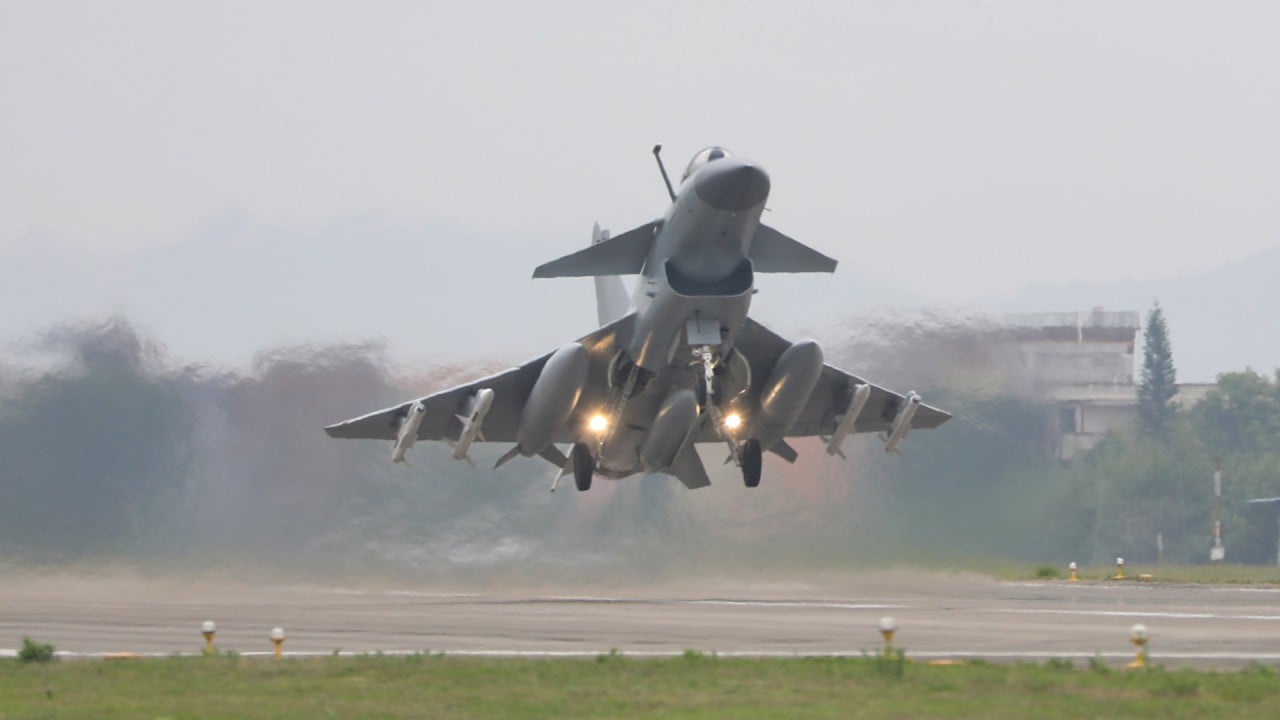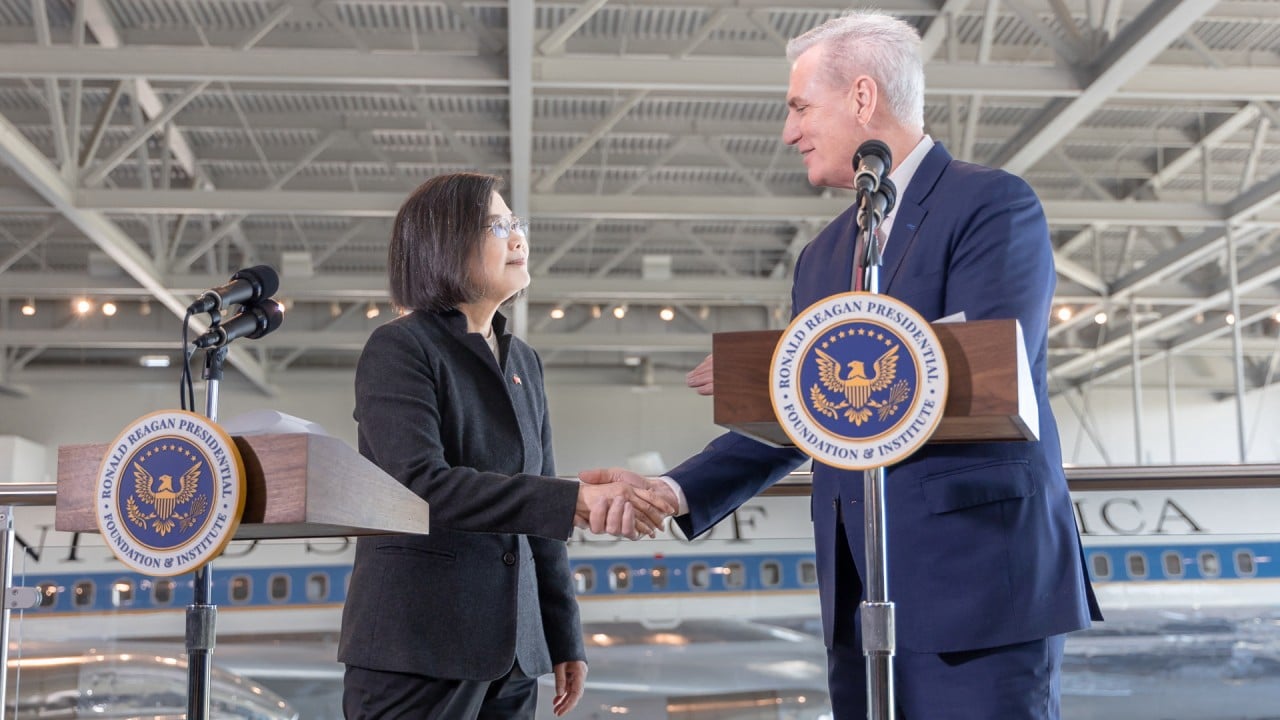
Taiwan stands to lose investment, supply chains, if PLA keeps up military drills
- Many US companies have been revising contingency plans as cross-strait tensions rise after the latest round of People’s Liberation Army (PLA) drills
- Latest flare-up follows a meeting between Taiwanese President Tsai Ing-wen and US House of Representatives speaker Kevin McCarthy in California
The possibility of more mainland Chinese military exercises near Taiwan could slowly push investors and suppliers away from the tech-dependent island if it threatens supply chains or raises the risk of actual conflict, analysts said.
Although the drills formally ended last Monday, the Taiwanese defence ministry said PLA aircraft continued to cross an informal Taiwan Strait median line between the two sides over the following two days, consistent with an almost daily pattern since mid-2020.
The behaviour of the PLA is understood, and companies for several years now have been looking at how they can de-risk their footprints in China and Taiwan
Beijing views the self-ruled island as a breakaway province that needs to be reunited with the mainland – by force if necessary. It insists on a one-China principle when dealing with the European Union, the United States and other countries, and repeatedly threatens actions against moves towards Taiwanese independence, which is advocated by the island’s ruling Democratic Progressive Party.
Analysts say multinationals – including Taiwan’s prized semiconductor firms, which pump out 60 per cent of the world’s chip supplies – are expected to double down on searches for production sites outside Taiwan, which could be a blow to the island’s US$829 billion economy.
“The behaviour of the PLA is understood, and companies for several years now have been looking at how they can de-risk their footprints in China and Taiwan, specifically,” said Rupert Hammond-Chambers, president of the US-Taiwan Business Council advocacy group.
Technology accounts for about 30 per cent of Taiwan’s gross domestic product (GDP). The industry covers a wide supply chain, from research and development to smartphone components and the mass assembly of common consumer electronics. Billions of dollars worth of goods leave Taiwan’s seaports every month for final assembly or for markets as far away as North America.
Many foreign investors who had explored opportunities in Taiwan, but not yet made a move, will look elsewhere after reading reports about the PLA drills and worrying that war might follow, said Kent Chong, a partner with the professional services firm PwC in Taipei.
“From a foreign perspective, it adds one more concern about Taiwan as a supply centre,” Chong said.
Taiwan’s economic affairs minister, Wang Mei-hua, said in Taipei last Monday that the island’s stock of liquid natural gas would last 11 days if imports were blockaded. Natural gas is forecast to make up half of Taiwan’s energy supply by 2025.
Investors already in Taiwan were likely to take a “wait-and-see attitude” as they evaluated new shipping routes, diversions of capital for new production or withdrawals from Taiwan, said Raymond Wu, president and chief executive of the Taipei-based e-telligence Research and Consulting Group.
“Entering a period of economic uncertainty, you have so many variables that are not economically related,” Wu said.
The economy would take a hit if investors eventually shifted away from Taiwan, he added.
If investment slows down, that doesn’t paint a very positive picture for the economy in the months ahead
“If investment slows down, that doesn’t paint a very positive picture for the economy in the months ahead,” Wu said.
Taiwan has been grappling with seven months of falling exports, due to sagging global demand for tech gear. And last week, the International Monetary Fund lowered its GDP growth forecast for Taiwan this year by 0.7 percentage points, to 2.1 per cent.
Fitch Ratings expects mainland-Taiwan tensions to “persist and remain a key credit weakness to Taiwan’s credit profile”, said the credit rating agency’s director of sovereigns, George Xu.
“The perception of heightened security risks by the international community could weigh on Taiwan’s competitive business climate and prompt multinational firms to reconsider their investment plans,” Xu said. “These factors could constrain Taiwan’s medium-term growth outlook.”
Nearly half of the American companies in Taiwan were revising mainland-conflict contingency plans as of February, according to a survey by the 437-member American Chamber of Commerce in Taiwan.
Airlines would be the first to change course, analysts said.
“Airlines operate realistically – their management is pragmatic and will react according to the situation,” said Shukor Yusof, founder of Singapore-based aviation consultancy Endau Analytics.
If war broke out, airlines might avoid Taiwan completely, he said.
There are numerous factors to take into account, such as costs, demand, talent acquisition, profitability, and government incentives
For most companies, contingency plans for exiting Taiwan would only be carried out on the brink of an actual conflict, Chong said.
Hammond-Chambers said future capital expenditure would seek new locations, “but some of the money will continue to maintain present infrastructure, which is overwhelmingly focused on North Asia”.
Any calculation on whether to pull out of Taiwan would be a complicated one, said Cheng Kai-an, a senior analyst with the Market Intelligence & Consulting Institute in Taipei.
“There are numerous factors to take into account, such as costs, demand, talent acquisition, profitability, and government incentives,” he said.
“For this reason, any company considering moving production offshore should take a cautious approach and is unlikely to do so because of temporary drills.”



